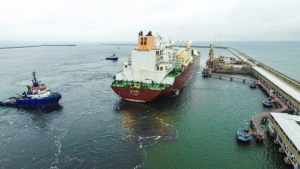Floating LNG terminal market. FSRU in Gdańsk

 LNG Terminal Świnoujście
LNG Terminal Świnoujście
By Marek Grzybowski, BSSC Baltic Journalist Club
The FSRU fleet will double by 2025, analysts at the Oxford Institute of Energy Studies predicted about 10 years ago. After Russia’s attack on Ukraine, it is clear that many European countries are looking for ways to increase the transshipment capacity of liquefied gas. In Poland, it was decided that the FSRU ship would dock in the Gulf of Gdańsk.
– The FSRU market developed in waves – noted Zlata Sergiejeva from KAPSARC, referring to the findings of the Oxford Institute of Energy Studies, which distinguished four waves. – The highest supply of FSRUs took place after 2017.
By 2017, the size of the FSRU fleet had already increased by about 60% since the beginning of the third wave in 2013. It is possible that we are now at the beginning of the fifth wave, triggered by some European countries trying to find an alternative to Russian pipeline gas and diversification of supply sources, notes Sergiejeva.
LNG on the ninth wave
More than a year after the Russian invasion of Ukraine and the resulting changes in LNG sea transport, the market remains dynamic. The demand for LNG carriers has increased and remains at a high level, filling the docks mainly of Chinese and Korean shipyards.
“In 2021, shipyard deliveries of LNG carriers reached a new record. The shipyards handed over 54 units with a capacity of 9.12 million m3 to the operators, according to Banchero Costa analysts. In 2022, deliveries decreased to 29 units with a total capacity of 4.52 million tonnes in 2022.
In 2023, approximately 35 units with a capacity of 5.40 million m3 will be delivered to the market, taking into account the delays in the production of some shipyards.
The order backlog for the coming years is very high and more than 260 units are expected to be delivered by 2026. In the event of an oversupply of the fleet of LNG carriers, some of them may be expanded with liquefaction or regasification functions after entering into service.
Gas tankers on the stock exchange
Stock market analysts drew attention to the market of gas carriers and gas-powered ships. The gas business and its players, especially operators and investors, have become an object of interest for banks. Barry Parker of SeatradeMaritime.com highlights Deutsche Bank’s Golar LNG team, trading on Nasdaq (GNLG).
New Fortress Energy (Nasdaq: NFE), which forms an alliance with FLNG terminals, has become the subject of interest, as well as FSRU Excelerate Energy (NYSE: EE), an entity also involved in investments in LNG terminals. The latter entity has 13 LNG terminals in nine countries and has been operating in their operation for almost two decades.
The company boasts that it is “committed to the mission of eliminating scarcity in energy resources and intends to make significant long-term investments in our projects, making us the ideal partner for countries seeking to achieve energy independence in a sustainable manner.”
FSRU in seaports
Experts from the Oxford Institute of Energy Studies calculated 5 years ago that there were 26 FSRU vessels in operation, of which 23 operated as terminals and 3 as LNG storage facilities. 10 were under construction and options for a further 10 were placed with the shipyards.
The IGU report estimated that nearly 50 FSRUs will be operational by 2025. Their processing capacity was forecast at nearly 200 tonnes of LNG imports per year, i.e. 60% of the global LNG production in 2016.
In 2023, there are approximately 55 active FSRUs in operation, including 4 launched in 2023 in Germany and one in Croatia, based on the LNG carrier Croatia moored on the island of Krk.
FSRU new or rebuilt?
Most FSRUs are new units, built with regasification installations. Some of them are rebuilt units. Converting a traditional LNG carrier to LNGC was still a year, two years ago about 50% cheaper than building a complete FSRU.
By mid-2022, the cost of conversion was estimated at around USD 100-150 million. Such a solution can be advantageous today for another reason as well. The docks for the construction of new vessels have already been contracted for several years. Therefore, the conversion of an LNG carrier may significantly shorten its commissioning for active operation as a regasification terminal.
For the operator of an older unit, rebuilding can also be an opportunity to extend its life as an FSRU. Thus, from an economic point of view, it is more advantageous for the owner of an LNG carrier to convert an old type vessel into an FSRU as an alternative to selling it to a scrap yard. In addition, a year’s stay in a repair shipyard is usually enough for conversion to LNGC standards. As a result, some FSRUs are tankers converted from older ships.
FSRU in Gdańsk Port
Gaz-System S.A. a month ago announced the transition to the 2nd stage of the procedure for selecting the operator to manage the FSRU terminal in Gdańsk. This is due to the fact that, as part of Phase 1 of the procedure, an Order to Proceed Agreement was concluded with the tender participant “who placed a binding order covering 100% of FSRU regasification services provided by Gaz-System”.
“The project involves the location of a floating FSRU (Floating Storage Regasification Unit) in the Gdańsk area, capable of unloading LNG, storing and regasifying LNG in the process,” informs Gaz System.
Gaz-System announces that “the FSRU terminal is to be adapted to conduct the regasification process at the level of 6.1 billion m3 of gaseous fuel per year. FSRU regasification services will be made available provided that Gaz-System S.A. undertakes a positive Final Investment Decision and the implementation of the investment within the assumed period – January 1, 2028.”
